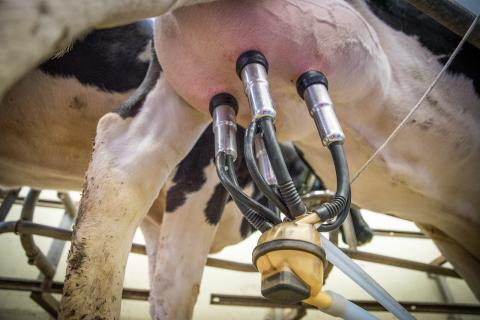Utilization of Fat and Protein as Indicators of Health Status of Your Holstein Herd
by Pete Erickson, Ph.D., UNH Extension Dairy Specialist
Your herd's fat and protein milk contents can be used as indicators of overall health. In a large study conducted in Northern Ireland over 20 years (1996-2016), milk fat and milk protein concentrations from 1,321 lactations were evaluated for their relation to intake, body weight, body condition score, blood levels of ketones and non-esterified fatty acids (NEFA; measures of ketosis) during the first 20 weeks of lactation.
The researchers found that the higher fat-to-protein ratio was strongly related to body weight loss, condition loss, and increased blood ketones. The ratio was greatest in early lactation when cows were in a negative energy balance. Interestingly, first- and second-lactation cows showed a less pronounced change in the ratio. This is likely due to these cows producing less milk as they are partitioning dietary nutrients towards growth.
How do you measure this?
Take the herd milk fat percent from your DHI data and divide it by your herd milk protein percent.
For example, on your DHI sheet, you find that the herd has a fat content of 4.0% and your protein content is 3.2%. Therefore, your fat-to-protein ratio is 4.0/3.2 = 1.25. This value would be considered ideal.
Likewise, if your herd fat test is 4.6% fat and your herd protein test is 3.0%, your fat-to-protein ratio is 4.6/3.0 = 1.53. This value could spell trouble. This indicates that the cows are losing too much weight and could be subject to subclinical ketosis.
If you notice a high fat-to-protein ratio (> 1.5), suggested remedies would be to feed more, check the energy density of your diet, and make sure that all cows have access to the bunk (don't overcrowd). Then, go to the herd and determine which cows are experiencing the potential disorder. (It should be noted that individual cows can be variable in this fat-to-protein calculation.) Therefore, evaluate each cow's ratio, but then further evaluate cows with a high fat-to-protein ratio for subclinical ketosis through urinary ketone test strips.
If your fat-to-protein ratio starts approaching a value of 1.0 the herd is likely to experience subacute ruminal acidosis. Check the amount of forage in the diet, and make sure there is adequate particle size, look for cows sorting feed, and try to correct the problem.
- Cabezas-Garcia, E.H., A.W. Gordon, F.J. Mulligan, and C.P. Ferris. 2021.Revisiting the relationships between fat-to-protein ratio in milk and energy balance in dairy cows of different parities, and at different stage of lactation. Animals 11:3256.
- Ehrecke / https://pixabay.com / 3455395
Extension Services & Tools That Help NH Farmers Grow
Newsletters: Choose from our many newsletters for production agriculture
Receive Pest Text Alerts - Text UNHIPM to (866) 645-7010


